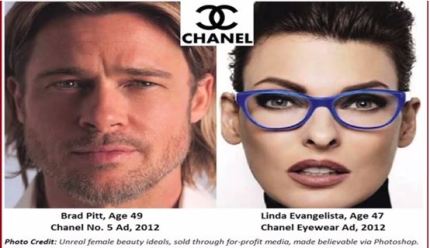All too often we tell ourselves that we are aware of the fact that images of models in magazines and on social media are photoshopped and enhanced. We know that these images do not necessarily represent real life. We recognise that such images are the work of a team of professional hair stylists, make -up artists, enhanced lighting, and the list goes on, but then why has it been statistically proven that these images cause real harm? Today more than ever girls and women, being exposed to such, and particularly from a young age, are more prone to eating disorders, depression and low self -esteem.
Ads and images normalise such expectations of what a female should look like. These images offer far more to the reader than the product they are selling. They play on our emotions, and sense of normality. They tell us that it is not okay not to be anything other than perfect.
These images have become so embedded and embraced as part of normal life that we have devised ways to achieve such looks. Girls are learning from an ever younger age that they need to look a certain way. A perfect example of this was highlighted by NYU Language Medical Centre. Among 5-12 grade girls (that’s equivalent to third class girls and up in the Irish system) said they wanted to lose weight. Over half of these girls said that they wanted to lose weight because of images they saw in magazines (Aboutourkids.org, 2015). Half of these girls also said they disliked their body image. This is troubling and sad, shouldn’t this be the last thing in the world for a kid to worry about? Isn’t it becoming obvious that body image is become an all too important measure of self-worth? Not only will these young kids fail in their attempts to resemble the photo in the magazine, teens and women of all ages will also fail because obtaining such is impossible. Images are photoshopped and enhanced. Women often feel like failures when they don’t even come close to resembling such images and so more and more products are bought to try and achieve the desired outcome.
We live in a society whereby we are constantly bombarded with the same message time and time again. Beauty is an incredibly thin, Caucasian and most importantly young women. Even other races are only considered beautiful if they resemble such features. The model Cameron Russell states in her video how this has become a “legacy” of today’s day and age http://
Video credit :(Russell, 2015)
Older women in particular are told over and over again that having wrinkles and grey hair is completely unacceptable. Society will not stand for it and you will be shunned if you dared venture outside with such a look. Anti -wrinkle creams, hair colors are but a few of an ever growing industry which prey on such notions of beauty. Below is an image of such. These two celebrities are more or less the same age yet, the woman has to be enhanced and photoshopped so as not to show any wrinkles, indeed she does not have a single flaw. Why is it that Linda cannot even look real but becomes a falsified version of what women really look like? Why is Brad allowed to resemble, at least, some form of himself?

Furthermore women are often showcased as things, as objects. Turning a human being into a thing is the most dehumanising thing that you can do, yet everywhere we turn we see this more and more. As a society we have simply learned to accept that is perfectly okay to showcase a female as such. Only certain parts of the body are showcased and the female body is simply seen as a thing or an object. Jean Kilbourne has captured this whole notion and I would urge you to watch the 4 minute video here:
Video credit: (Killing Us Softly, 2010)
It certainly opened my eyes to just how pronounced this issue is!
The harsh reality is that even though we may be all too aware of the falseness of these ads, they are having more of an impact on us than we may realise.
Bibliography
Aboutourkids.org, (2015). How to Raise Girls with Healthy Self-Esteem | AboutOurKids.org. [online] Available at: http://www.aboutourkids.org/articles/how_raise_girls_healthy_selfesteem [Accessed 5 Feb. 2015].
BEAUTY REDEFINED, (2012). Photoshop Phoniness: Hall of Shame. [online] Available at: http://www.beautyredefined.net/photoshop-phoniness-hall-of-shame/ [Accessed 5 Feb. 2015].
Killing Us Softly, (2010). [TV programme] YouTube.
Russell, C. (2015). Looks aren’t everything. Believe me, I’m a model.. [online] Ted.com. Available at: http://www.ted.com/talks/cameron_russell_looks_aren_t_everything_believe_me_i_m_a_model?language=en#t-369473 [Accessed 5 Feb. 2015].

Hello Sarah (Ms. Doran), Glad to be connecting electronically. Given your interest, you might find this (not by me) of interest: http://zeteojournal.com/2015/02/09/fear-aging/
May you be somewhere warm, Wm. Eaton, Montaigbakhtinian
LikeLike
Thanks! I’ll check it out! 🙂
LikeLike
loving your blog and its emphasis on the media and its powers, particularly in relation to body image- something i am passionate about changing!! well done…
LikeLike
Thank you so much!! I’m passionate about it too so the more people aware the better!
LikeLiked by 1 person
you might like my blog as I take a similar angle 😉
LikeLiked by 1 person